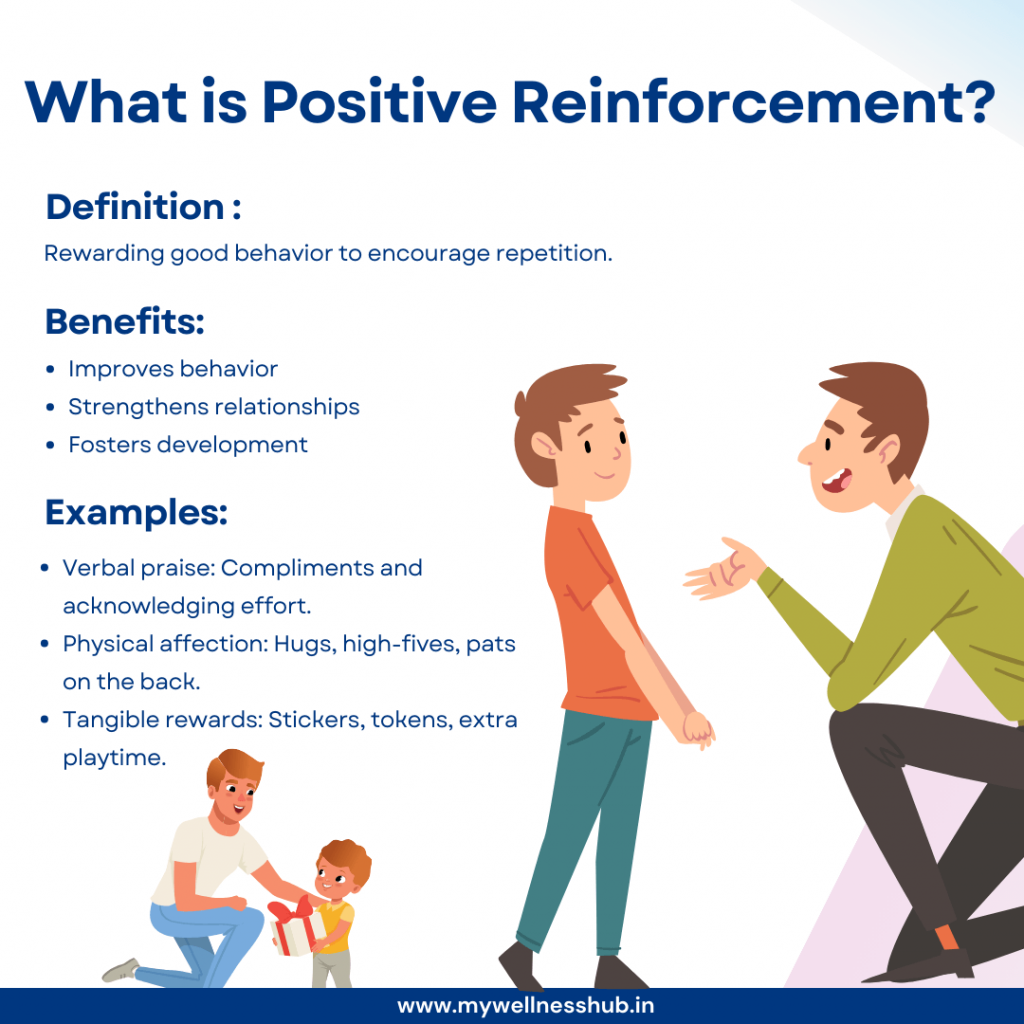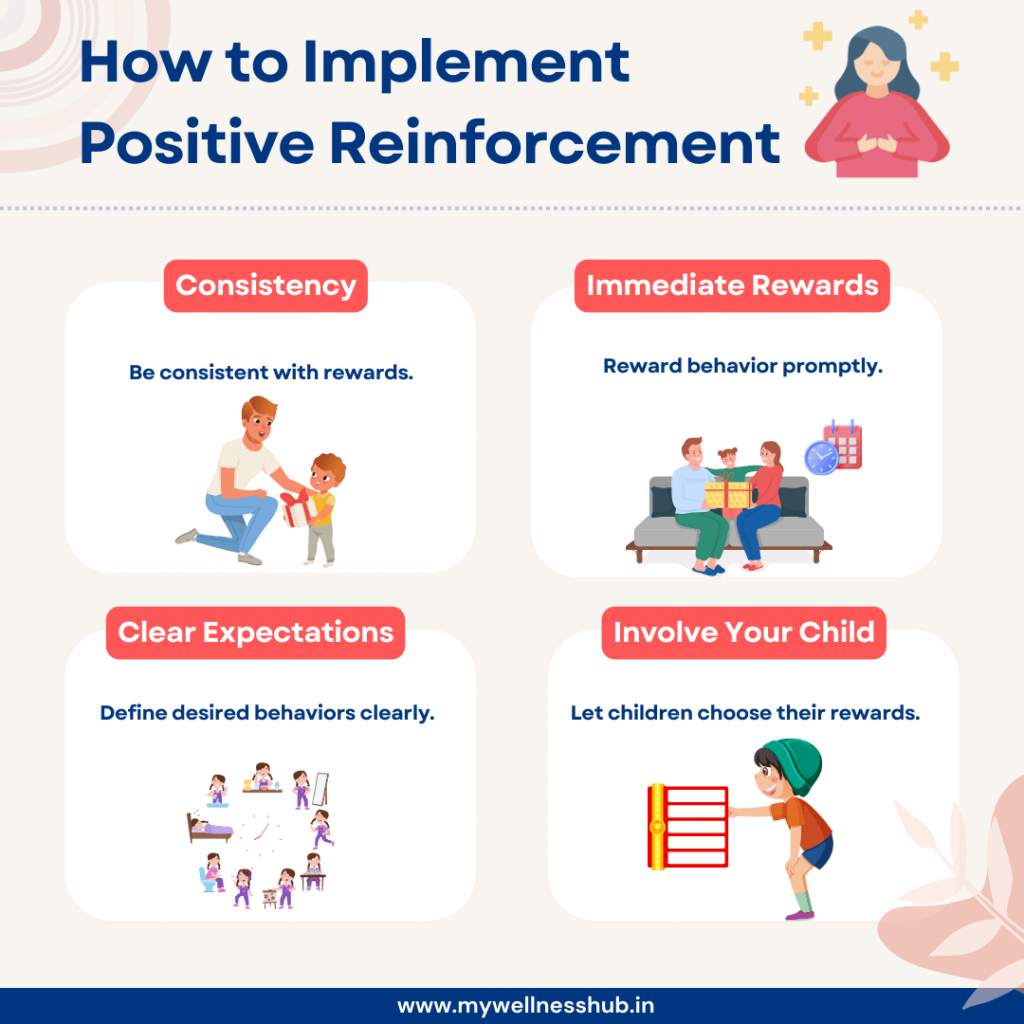Top Positive Reinforcement Methods for Parents
By Wellness Hub
Last Updated: July 16, 2024
Embarking on the parenting voyage brings a blend of joy and challenges, each moment ripe with lessons. At the heart of these lessons is a powerful tool: Positive Reinforcement. This method, more than just a parenting tactic, is a gateway to nurturing your child’s best qualities. By rewarding commendable behaviors, you not only encourage these actions to flourish but also deepen your bond with your child. Picture the delight and pride that sparkle in your child’s eyes as they receive praise for their efforts—be it finishing homework or assisting in household tasks. Such moments do more than please; they fortify confidence and self-esteem, setting the foundation for a thriving future.
Also read: Online Behavioral Therapy for Kids

Benefits of Positive Reinforcement
Positive reinforcement is more than just a parenting technique; it’s a powerful tool that can bring about significant improvements in your child’s behavior and overall development. Let’s explore some of the key benefits of incorporating positive reinforcement into your parenting strategy.
1. Improved Behavior and Increased Prosocial Actions
One of the most immediate benefits of positive reinforcement is improved behavior. When you consistently reward your child for positive actions, such as sharing, following directions, or completing chores, you encourage them to repeat these behaviors. This method helps in shaping a child’s actions towards more prosocial behaviors, which include being kind, cooperative, and helpful. Over time, your child learns that positive behaviors lead to positive outcomes, making them more likely to continue acting in ways that are beneficial to themselves and those around them.
2. Strengthened Parent-Child Relationship
Positive reinforcement also plays a crucial role in strengthening the parent-child relationship. When you focus on your child’s strengths and acknowledge their good behaviors, you create a supportive and loving environment. This approach fosters trust and mutual respect. Your child feels valued and understood, which enhances their emotional bond with you. A strong parent-child relationship built on positive interactions can lead to better communication, reduced conflicts, and a more harmonious household.
3. Long-Term Positive Impact on a Child’s Development
The effects of positive reinforcement go beyond immediate behavior changes; they contribute to long-term positive development. Children who experience regular positive reinforcement tend to develop higher self-esteem and confidence. They become more motivated to take on challenges and persevere through difficulties, knowing that their efforts will be recognized and appreciated. Additionally, positive reinforcement encourages a growth mindset, where children learn to value effort and improvement over innate abilities. This mindset is crucial for their academic, social, and emotional development.
Top Positive Reinforcement Methods
Implementing positive reinforcement methods effectively can transform your parenting approach, making it more rewarding for both you and your child. Here are some top methods to consider:
1. Verbal Praise and Encouragement
Verbal praise is one of the simplest yet most powerful forms of positive reinforcement.
Examples: Compliments, acknowledging effort, specific praise.
How to use: Be consistent and specific with your praise. Instead of just saying “Good job,” try “I’m really impressed with how you finished your homework on time today!” Specific praise helps your child understand exactly what behavior is being acknowledged and encouraged.
Also read: Online Behavioral Therapy for Kids with Autism
2. Physical Affection and Gestures
Physical affection can go a long way in reinforcing positive behavior and showing your child that you appreciate their efforts.
Examples: Hugs, high-fives, pats on the back.
How to use: Pair physical affection with verbal praise for maximum effect. For instance, give a hug along with saying, “I’m so proud of you for sharing your toys with your sister.”
3. Tangible Rewards
Sometimes, a little extra incentive can be a great motivator for children.
Examples: Stickers, tokens, extra playtime.
How to use: Establish a reward system, such as a token economy. For example, your child can earn a token for each completed task, which they can then exchange for a larger reward, like a special outing or a new toy. This method not only motivates but also teaches the value of working towards a goal.
4. Privileges and Special Activities
Offering extra privileges or special activities as rewards can be highly motivating for children.
Examples: Extra screen time, choosing a family activity.
How to use: Link privileges to specific behaviors. For instance, if your child completes their chores without being reminded, they can earn extra screen time or choose a family game to play. This connection helps children understand the direct benefits of their positive actions.
Behavior Charts and Visual Aids
Visual aids like behavior charts can help children see their progress and stay motivated.
Examples: Sticker charts, behavior graphs.
How to use: Track progress and provide visual reinforcement. Create a chart where your child can add a sticker each time they exhibit a desired behavior. Seeing the stickers accumulate provides a tangible sense of accomplishment and encourages them to keep up the good work.
Types of Positive Reinforcement
| Method | Examples | How to Use |
|---|---|---|
| Verbal Praise | – Compliments – Acknowledging effort – Positive feedback in front of others | – Be consistent and specific – Use specific praise (e.g., “Great job on your homework today!”) – Reinforce immediately after the positive behavior |
| Physical Affection | – Hugs – High-fives – Pats on the back | – Pair with verbal praise – Use physical gestures to show approval and support – Ensure the affection is appropriate and comfortable for the child |
| Tangible Rewards | – Stickers – Tokens – Extra playtime | – Establish a reward system, such as a token economy – Use tangible items sparingly and as part of a broader strategy – Gradually reduce reliance on tangible rewards over time |
| Privileges | – Extra screen time – Choosing a family activity – Additional responsibilities | – Link privileges directly to specific positive behaviors – Clearly explain the connection between the behavior and the privilege – Adjust privileges based on age and maturity |
| Behavior Charts | – Sticker charts – Behavior graphs – Progress trackers | – Track progress visually using charts and graphs – Regularly update and review the charts with your child – Celebrate milestones and achievements visually |
How to Implement Positive Reinforcement Effectively
Implementing positive reinforcement effectively can make a significant difference in your child’s behavior and overall development. Here are some key strategies to ensure you’re getting the most out of this approach:
Consistency is Key
Consistency is crucial when it comes to positive reinforcement. Children need to know that good behavior will always be recognized and rewarded. If rewards are given sporadically, it can be confusing and may undermine the effectiveness of the reinforcement.
Why it matters: Consistent rewards help children understand the connection between their actions and the positive outcomes. This clear link reinforces the behavior you want to see more of.
How to be consistent: Set a schedule or a system for rewards. For example, if you’re using a sticker chart, make sure you add a sticker every time your child exhibits the desired behavior, without fail. Consistency builds trust and reliability in the reinforcement process.

Immediate Reinforcement
For positive reinforcement to be most effective, it should be given as soon as possible after the desired behavior occurs. Immediate rewards help solidify the connection between the action and the positive outcome in your child’s mind.
Why it matters: The quicker the reward follows the behavior, the stronger the association. This immediate feedback encourages your child to repeat the behavior.
How to do it: Keep rewards simple and accessible. Verbal praise, a high-five, or a sticker can be given right away. For more substantial rewards, such as extra playtime or a special activity, acknowledge the good behavior immediately and explain the reward will follow.
Also Read: How Behavioral Therapy Helps Kids with ADHD
Setting Clear Expectations
Clearly defining the behaviors you want to reinforce is essential. Your child needs to understand what is expected of them to meet those expectations and receive rewards.
Why it matters: Clear expectations eliminate confusion and ensure that your child knows exactly what behaviors will be rewarded. This clarity helps them focus on meeting those specific goals.
How to set expectations: Use simple, concise language to explain what you want. For example, instead of saying, “Be good,” specify, “Please put your toys away after playing.” Consistently remind and reinforce these expectations.
Involving the Child
Allowing your child to have a say in choosing their rewards can increase their motivation and engagement. When children feel involved in the process, they are more likely to be excited about working towards their goals.
Why it matters: Involvement gives children a sense of control and ownership over their behavior and the rewards they earn. This empowerment can boost their motivation and enthusiasm.
How to involve your child: Discuss potential rewards with your child and let them choose from a list of acceptable options. For example, you could ask, “Would you prefer extra screen time or a trip to the park?” This choice makes the reward more meaningful to them.
Common Mistakes and How to Avoid Them
Using positive reinforcement effectively can be incredibly rewarding, but there are some common pitfalls that parents can encounter. Here’s how to avoid them:
Overusing Rewards
Balancing tangible rewards with intrinsic motivation is crucial. While it’s tempting to offer rewards frequently to encourage good behavior, over-reliance on them can reduce their effectiveness over time. More importantly, it can overshadow the development of intrinsic motivation, where your child learns to appreciate the inherent satisfaction of their actions.
How to avoid it: Use tangible rewards sparingly and focus more on verbal praise and physical affection. Gradually decrease the frequency of tangible rewards as your child begins to exhibit the desired behavior more consistently. Encourage your child to reflect on how good it feels to accomplish something, emphasizing the internal satisfaction they get from doing well.
Example: If your child finishes their homework on time, you can say, “I’m really proud of you for managing your time so well. How do you feel about getting your homework done early?”
Inconsistent Application
Consistency is key in positive reinforcement. Inconsistent application of rewards can confuse your child and weaken the association between their good behavior and the positive outcomes they receive.
How to avoid it: Set clear guidelines for what behaviors will be rewarded and stick to them. If you decide that helping with chores earns a reward, make sure to acknowledge it every time it happens. Consistency helps reinforce the behavior you want to see.
Example: If you’ve agreed that your child earns a sticker for each completed chore, make sure they get a sticker every time they complete a chore without being reminded.
Accidental Reinforcement of Negative Behavior
It’s easy to unintentionally reinforce negative behaviors, especially when trying to manage challenging situations. Sometimes, giving attention to negative behavior can encourage it to continue.
How to avoid it: Be mindful of how you respond to negative behavior. Instead of giving attention to the negative actions, focus on and reward positive behaviors. If your child is acting out to get your attention, try to ignore the negative behavior and acknowledge positive actions instead.
Example: If your child is whining for a snack before dinner, don’t give in to the whining. Instead, praise them when they ask politely or wait patiently, saying, “I really appreciate how you asked nicely for a snack. Let’s have one after dinner.”
Long-Term Positive Reinforcement Strategies
Positive reinforcement is not just about immediate rewards; it’s also about fostering long-term positive behaviors and attitudes in your child. Here are some strategies to ensure that the benefits of positive reinforcement are sustained over time.
Gradual Reduction of Tangible Rewards
While tangible rewards like stickers or toys can be effective in the short term, it’s important to gradually reduce their use. Over-reliance on these rewards can diminish their impact and may prevent your child from developing intrinsic motivation.
How to do it: Slowly phase out tangible rewards by extending the intervals between them. For example, if your child is used to receiving a sticker every day for completing their chores, start giving the sticker every other day, then every third day, and so on. This gradual reduction helps your child transition to appreciating the intrinsic satisfaction of a job well done.
Example: “I noticed you’ve been doing a great job with your homework. Instead of a sticker every day, how about we celebrate with a special outing at the end of the week?”
Fostering Intrinsic Motivation
Intrinsic motivation refers to engaging in behavior because it is inherently rewarding, not because of external rewards. Encouraging your child to find joy and satisfaction in their actions can lead to more sustainable positive behaviors.
How to do it: Highlight the natural consequences and internal rewards of good behavior. Praise your child for the effort they put in and help them recognize the satisfaction that comes from achieving their goals.
Example: “You must feel really proud of yourself for finishing that book all by yourself! How do you feel about your accomplishment?”
Encouraging Self-Reinforcement and Self-Regulation
Self-reinforcement involves your child recognizing and rewarding themselves for their positive behaviors, while self-regulation is about managing their own behavior without external prompts. Teaching these skills can empower your child to take ownership of their actions.
How to do it: Encourage your child to set personal goals and celebrate their achievements. Teach them to reflect on their behavior and recognize their own progress. Provide opportunities for them to make decisions and solve problems independently.
Example: “You did a great job organizing your toys today. How about you choose a fun activity for yourself as a reward?”
Conclusion
In conclusion, positive reinforcement isn’t just a strategy; it’s a transformative approach to parenting that nurtures your child’s development and fortifies your familial bonds. By adopting methods like verbal praise and tangible rewards, and steering clear of pitfalls such as inconsistency, you empower your child towards self-motivation and improved behavior. Embrace this journey with the right tools and a consistent mindset, and the results—happier, more confident children and a harmonious home—are immeasurable. For more insights and resources, turn to Wellness Hub, your ally in fostering a nurturing, positive environment for your family.
Frequently Asked Questions:
1. What are positive reinforcement methods for parents?
Positive reinforcement methods for parents include rewarding children for good behavior with verbal praise, physical affection, tangible rewards, privileges, and behavior charts. These techniques encourage positive actions and strengthen the parent-child relationship.
2. How can I use positive reinforcement to improve my child’s behavior?
You can use positive reinforcement to improve your child’s behavior by consistently rewarding desired actions immediately after they occur. Be specific with your praise and use a variety of rewards to keep your child motivated.
3. What are some examples of positive reinforcement techniques?
Examples of positive reinforcement techniques include giving compliments, hugging, giving high-fives, offering stickers or tokens, granting extra screen time, and using behavior charts to track progress.
4. Why is consistency important in positive reinforcement?
Consistency is important in positive reinforcement because it helps children understand the connection between their behavior and the rewards they receive. Consistent rewards make it clear which behaviors are encouraged, leading to more predictable and positive actions.
5. How can I balance tangible rewards with intrinsic motivation?
To balance tangible rewards with intrinsic motivation, gradually reduce the use of tangible rewards over time and emphasize the internal satisfaction that comes from positive behavior. Encourage your child to recognize their own achievements and the natural consequences of their actions.
6. What should I do if I accidentally reinforce negative behavior?
If you accidentally reinforce negative behavior, try to shift your focus to positive actions instead. Ignore the negative behavior as much as possible and reward positive behavior when it occurs. Consistently apply this approach to change your child’s behavior over time.
7. How can I involve my child in the positive reinforcement process?
You can involve your child in the positive reinforcement process by letting them choose their rewards and set personal goals. This involvement increases their motivation and gives them a sense of ownership over their behavior and achievements.
8. What long-term strategies can I use for positive reinforcement?
Long-term strategies for positive reinforcement include gradually reducing tangible rewards, fostering intrinsic motivation, and encouraging self-reinforcement and self-regulation. These approaches help children develop a deeper sense of responsibility and self-motivation.
9. Why should I consider using positive reinforcement over other discipline methods?
Positive reinforcement focuses on encouraging good behavior rather than punishing bad behavior. This approach helps build a positive relationship between you and your child, reduces stress, and creates a more harmonious home environment.
10. Where can I find more resources on positive reinforcement and parenting?
For more resources on positive reinforcement and parenting, visit Wellness Hub. Wellness Hub offers a variety of guides, tools, and advice to support you in creating a positive and nurturing environment for your child.
About Author:
Lasya Vooturi
Clinical Psychologist and Behavioral Therapist
Lasya holds a Professional Diploma in Clinical Psychology from Amity University, where she deepened her understanding of psychological principles from March 2023 to March 2024. With over a year of dedicated experience as a Behavioral Therapist, Lasya has honed her skills in applying effective therapy techniques tailored to individual needs. Fluent in Telugu, Hindi, and English, she is adept at connecting with a diverse range of clients, ensuring comprehensive communication and understanding. Lasya’s approach is grounded in empathy and scientific rigor, making her a trusted ally in navigating mental health challenges.
Book your Free Consultation Today
Parent/Caregiver Info:
Client’s Details:
* Error Message








